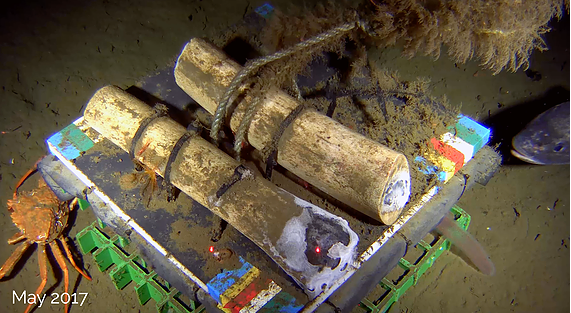Historias SubC: Continúa el estudio de los huesos de ballena en el cañón de Barkley con el Observatorio de la Cámara Submarina
Monitoring how benthic organisms utilize the sparse food resources available in deep-sea settings
Permanent presence on the seafloor allowing for long-term observation
Thanks to SubC Imaging’s Observatory System, researchers are able to establish large-scale patterns of biodiversity and ecosystem function
Led by Professor Craig Smith (University of Hawaii at Manoa), Professor Lisa Levin (Scripps Institution of Oceanography), and Dr. Fabio De Leo (Ocean Networks Canada), the University of Victoria have been using SubC’s Observatory Solution for their underwater study in Barkley Canyon since 2014.
In May 2014, three humpback whale (Megaptera novaeangliae) rib sections, one 20x20x10 block of Douglas Fir (Pseudotsunga meniziesi), and a ~ 30x30x30 block of authigenic carbonate were placed at a depth of 890m inside the Barkley Canyon -- a site at Ocean Networks Canada NEPTUNE subsea camera observatory. The purpose of this scientific experiment is to monitor the changes triggered by the implantation of various organic and inorganic substrates as well as monitor how benthic organisms utilize the sparse food resources available in deepsea settings.
Full Control of Deep-Sea Observations
Las imágenes que se muestran en el vídeo timelapse de Barkley Canyon proceden de una nueva generación de cámaras inteligentes SubC que la Universidad de Victoria actualizó a mitad del proyecto.
Cada dos horas, las cámaras submarinas autónomas y los LEDs se desplazaron hacia los tres sustratos y, manteniendo su posición durante un minuto en cada uno, capturaron vídeos de cinco minutos.
"Es la primera vez que podemos controlar nuestras observaciones en aguas profundas grabando los experimentos diariamente cada dos horas y encendiendo las luces en cualquier momento para realizar más observaciones". - Dr. Fabio De Leo
Cost Efficient, Long-Term Observation
Setting up a cabled ocean observatory created a permanent presence on the seafloor allowing for long-term observation. This also eliminated the need for costly, more time-consuming monitoring via multiple deployments of ROVs or AUVs in order to gather the data. With the help of the Observatory Solution, the researchers are able to establish large-scale patterns of biodiversity and ecosystem function in areas where there are whale bones.
Referencias
Citación: De Leo, Fabio & Smith, Craig R. & Levin, Lisa & Fleury, Aharon (2016). Procesos sucesionales bentónicos tempranos en sustratos implantados en el Cañón Submarino Barkley afectados por una zona mínima de oxígeno permanente, American Geophysical Union 2016. Bibcode: 2016AGUOSME34B0796C
Biodiversidad, conectividad y función del ecosistema en hábitats ricos en materia orgánica de huesos de ballena y cascadas en el Cañón Barkley
https://www.oceannetworks.ca/whalebone-experiment-minimum-oxygen-zone
Investigador en residencia: Craig Smith sobre las cataratas de ballenas
https://www.oceannetworks.ca/researcher-residence-craig-smith-whale-falls

